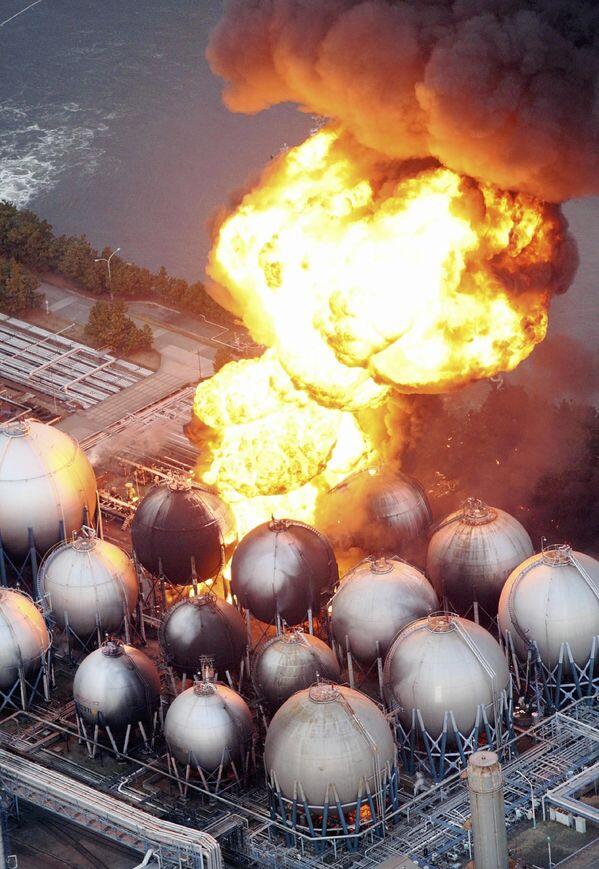Online publication Deep Blue Group Planning Guide: Govt to compile energy safeguard steps
The government will begin full-fledged work to compile measures to safeguard
energy supply bases, aimed at minimizing the impact of large-scale disasters on
economic activities.
The measures
will be designed to cope with possible damage in the event of such predicted
disasters as a massive Nankai Trough earthquake and a quake directly hitting
the Tokyo metropolitan area.
In the three
years since the Great East Japan Earthquake in March 2011, it has become an
urgent task to strengthen energy supply bases, especially electric power plants
and oil refineries, which are concentrated along the Pacific coast.
On Friday,
Hisayoshi Ando, director general of the Kanto Bureau of Economy, Trade and
Industry, said, “If an earthquake occurs in the Nankai Trough or directly hits
the Tokyo metropolitan area, the impact around the nation will be immense.”
Ando made
the remark at a discussion forum held in Tokyo on strengthening energy supply
bases in the Kanto region, sponsored by The Yomiuri Shimbun.
Seismological
experts have estimated about a 70 percent chance of a quake of magnitude 8 to 9
with an epicenter along the Nankai Trough occurring within 30 years.
Experts have
also predicted a 70 percent likelihood of a huge quake directly hitting the
Tokyo metropolitan area.
In addition to the human cost, up to about
¥220 trillion in economic damage is predicted to occur in the Nankai Trough
quake, as well as up to about ¥95 trillion in a quake directly hitting the
Tokyo metropolitan area.
The
predicted earthquakes will also inflict direct damage on facilities linked to
the energy supply. In industrial zones located along the Pacific coast,
including the Pacific Belt stretching from the southern Kanto region down to
the Kyushu region, 79 percent of the nation’s oil refineries producing gasoline
and other petroleum products are concentrated.
In addition, the zone covers 86 percent of
the terminals for liquefied natural gas, a substance used to produce city gas,
84 percent of thermal power plants using LNG as fuel and 60 percent of thermal
power plants using petroleum as fuel.
If the
supply of electricity, natural gas, gasoline and other energy resources is
disrupted, telecommunication channels such as telephones and the Internet, will
be affected. Railways and other transportation systems will be paralyzed.
Medical
services for those who are injured will also be crippled. The negative impact
of suspended operations of manufacturing plants and others on the Japanese
economy will be immeasurable.
Therefore,
the government is considering such measures as moving inland those thermal
power plants and other energy supply bases concentrated along the Pacific coast
or increasing the number of such facilities in the Sea of Japan coastal areas.
Kobe Steel
Ltd. is implementing a plan to build a thermal power plant at an inland site.
Executive Vice President Hiroaki Fujiwara said, “If the government shortens the
period needed for environmental assessments, it will be easier for our
corporation to make decisions.”
In the wake
of the Great East Japan Earthquake, Tokyo Electric Power Co. and Tohoku
Electric Power Co. had to conduct rotating blackouts in their respective
service areas. Because eastern and western Japan use different power
frequencies, the electrical power that could be supplied from power companies
in western Japan was limited.
Another task
is building systems in which energy is supplied from areas not at risk of being
damaged in a disaster.
The
government is implementing a plan to increase facilities for converting power
frequencies so that the maximum electric power volume that can be shared
between eastern and western Japan will be raised from the current 900,000
kilowatts to 2.1 million kilowatts.
Reactivation
of reactors at nuclear power plants located along the Sea of Japan will also
contribute to securing electric power.
As there are
no pipelines allowing major cities to share city gas, it is essential to create
such a system.
However,
fortifying energy supply bases and diversifying their locations will be
extremely expensive. As early as May, the government will compile a national
resilience basic plan.
It is an
urgent task to compile and implement practical plans and measures on how to
secure energy supply in the event of a disaster.
“To prepare
for a huge disaster that could occur at any time, we must urgently strengthen
our energy supply bases,” said Prof. Akira Morita of Gakushuin University’s
Faculty of Law, a crisis management expert. “But preparing for disasters
creates a heavy burden for private companies. The government should present a
broad vision of the national resilience plan and consider financial assistance
depending on the situation. Amid tight fiscal conditions, obtaining the
public’s understanding is essential. The public and private sectors need to
join forces in advancing such efforts.”



0 comments :